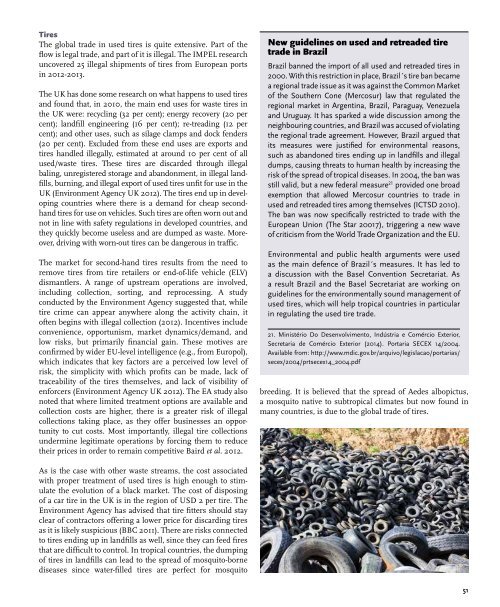WASTE CRIME – WASTE RISKS
6VhhXcA80
6VhhXcA80
Create successful ePaper yourself
Turn your PDF publications into a flip-book with our unique Google optimized e-Paper software.
Tires<br />
The global trade in used tires is quite extensive. Part of the<br />
flow is legal trade, and part of it is illegal. The IMPEL research<br />
uncovered 25 illegal shipments of tires from European ports<br />
in 2012-2013.<br />
The UK has done some research on what happens to used tires<br />
and found that, in 2010, the main end uses for waste tires in<br />
the UK were: recycling (32 per cent); energy recovery (20 per<br />
cent); landfill engineering (16 per cent); re-treading (12 per<br />
cent); and other uses, such as silage clamps and dock fenders<br />
(20 per cent). Excluded from these end uses are exports and<br />
tires handled illegally, estimated at around 10 per cent of all<br />
used/waste tires. These tires are discarded through illegal<br />
baling, unregistered storage and abandonment, in illegal landfills,<br />
burning, and illegal export of used tires unfit for use in the<br />
UK (Environment Agency UK 2012). The tires end up in developing<br />
countries where there is a demand for cheap secondhand<br />
tires for use on vehicles. Such tires are often worn out and<br />
not in line with safety regulations in developed countries, and<br />
they quickly become useless and are dumped as waste. Moreover,<br />
driving with worn-out tires can be dangerous in traffic.<br />
The market for second-hand tires results from the need to<br />
remove tires from tire retailers or end-of-life vehicle (ELV)<br />
dismantlers. A range of upstream operations are involved,<br />
including collection, sorting, and reprocessing. A study<br />
conducted by the Environment Agency suggested that, while<br />
tire crime can appear anywhere along the activity chain, it<br />
often begins with illegal collection (2012). Incentives include<br />
convenience, opportunism, market dynamics/demand, and<br />
low risks, but primarily financial gain. These motives are<br />
confirmed by wider EU-level intelligence (e.g., from Europol),<br />
which indicates that key factors are a perceived low level of<br />
risk, the simplicity with which profits can be made, lack of<br />
traceability of the tires themselves, and lack of visibility of<br />
enforcers (Environment Agency UK 2012). The EA study also<br />
noted that where limited treatment options are available and<br />
collection costs are higher, there is a greater risk of illegal<br />
collections taking place, as they offer businesses an opportunity<br />
to cut costs. Most importantly, illegal tire collections<br />
undermine legitimate operations by forcing them to reduce<br />
their prices in order to remain competitive Baird et al. 2012.<br />
New guidelines on used and retreaded tire<br />
trade in Brazil<br />
Brazil banned the import of all used and retreaded tires in<br />
2000. With this restriction in place, Brazil´s tire ban became<br />
a regional trade issue as it was against the Common Market<br />
of the Southern Cone (Mercosur) law that regulated the<br />
regional market in Argentina, Brazil, Paraguay, Venezuela<br />
and Uruguay. It has sparked a wide discussion among the<br />
neighbouring countries, and Brazil was accused of violating<br />
the regional trade agreement. However, Brazil argued that<br />
its measures were justified for environmental reasons,<br />
such as abandoned tires ending up in landfills and illegal<br />
dumps, causing threats to human health by increasing the<br />
risk of the spread of tropical diseases. In 2004, the ban was<br />
still valid, but a new federal measure 21 provided one broad<br />
exemption that allowed Mercosur countries to trade in<br />
used and retreaded tires among themselves (ICTSD 2010).<br />
The ban was now specifically restricted to trade with the<br />
European Union (The Star 20017), triggering a new wave<br />
of criticism from the World Trade Organization and the EU.<br />
Environmental and public health arguments were used<br />
as the main defence of Brazil´s measures. It has led to<br />
a discussion with the Basel Convention Secretariat. As<br />
a result Brazil and the Basel Secretariat are working on<br />
guidelines for the environmentally sound management of<br />
used tires, which will help tropical countries in particular<br />
in regulating the used tire trade.<br />
21. Ministério Do Desenvolvimento, Indústria e Comércio Exterior,<br />
Secretaria de Comércio Exterior (2014). Portaria SECEX 14/2004.<br />
Available from: http://www.mdic.gov.br/arquivo/legislacao/portarias/<br />
secex/2004/prtsecex14_2004.pdf<br />
breeding. It is believed that the spread of Aedes albopictus,<br />
a mosquito native to subtropical climates but now found in<br />
many countries, is due to the global trade of tires.<br />
As is the case with other waste streams, the cost associated<br />
with proper treatment of used tires is high enough to stimulate<br />
the evolution of a black market. The cost of disposing<br />
of a car tire in the UK is in the region of USD 2 per tire. The<br />
Environment Agency has advised that tire fitters should stay<br />
clear of contractors offering a lower price for discarding tires<br />
as it is likely suspicious (BBC 2011). There are risks connected<br />
to tires ending up in landfills as well, since they can feed fires<br />
that are difficult to control. In tropical countries, the dumping<br />
of tires in landfills can lead to the spread of mosquito-borne<br />
diseases since water-filled tires are perfect for mosquito<br />
51


